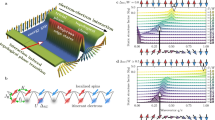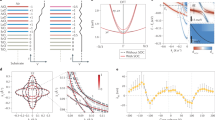Abstract
Spin–orbit coupling is a fundamental interaction in solids that can induce a broad range of unusual physical properties, from topologically non-trivial insulating states to unconventional pairing in superconductors1,2,3,4,5,6,7. In iron-based superconductors its role has, so far, not been considered of primary importance, with models based on spin- or orbital fluctuations pairing being used most widely8,9,10. Using angle-resolved photoemission spectroscopy, we directly observe a sizeable spin–orbit splitting in all the main members of the iron-based superconductors. We demonstrate that its impact on the low-energy electronic structure and details of the Fermi surface topology is stronger than that of possible nematic ordering11,12,13. The largest pairing gap is supported exactly by spin–orbit-coupling-induced Fermi surfaces, implying a direct relation between this interaction and the mechanism of high-temperature superconductivity.
This is a preview of subscription content, access via your institution
Access options
Subscribe to this journal
Receive 12 print issues and online access
$259.00 per year
only $21.58 per issue
Buy this article
- Purchase on SpringerLink
- Instant access to full article PDF
Prices may be subject to local taxes which are calculated during checkout





Similar content being viewed by others
References
Jungwirth, T., Wunderlich, J. & Olejnik, K. Spin Hall effect devices. Nature Mater. 11, 382–390 (2012).
Hasan, M. Z. & Kane, C. L. Topological insulators. Rev. Mod. Phys. 82, 3045–3067 (2010).
Mourik, V. et al. Signatures of Majorana fermions in hybrid superconductor–semiconductor nanowire devices. Science 336, 1003–1007 (2012).
Caviglia, A. D. et al. Tunable Rashba spin–orbit interaction at oxide interfaces. Phys. Rev. Lett. 104, 126803 (2010).
Dikin, D. A. et al. Coexistence of superconductivity and ferromagnetism in two dimensions. Phys. Rev. Lett. 107, 056802 (2011).
Gardner, H. J. et al. Enhancement of superconductivity by a parallel magnetic field in two-dimensional superconductors. Nature Phys. 7, 895–900 (2011).
Haverkort, M. W. et al. Strong spin–orbit coupling effects on the Fermi surface of Sr2RuO4 and Sr2RhO4 . Phys. Rev. Lett. 101, 026406 (2008).
Kuroki, K. et al. Unconventional pairing originating from the disconnected Fermi surfaces of superconducting LaFeAsO1−xFx . Phys. Rev. Lett. 101, 087004 (2008).
Hirschfeld, P., Korshunov, M. & Mazin, I. Gap symmetry and structure of Fe-based superconductors. Rep. Prog. Phys. 74, 124508 (2011).
Kontani, H. & Onari, S. Orbital-fluctuation-mediated superconductivity in iron pnictides: Analysis of the five-orbital Hubbard–Holstein model. Phys. Rev. Lett. 104, 157001 (2010).
Nakayama, K. et al. Reconstruction of band structure induced by electronic nematicity in an FeSe superconductor. Phys. Rev. Lett. 113, 237001 (2014).
Shimojima, T. et al. Lifting of xz/yz orbital degeneracy at the structural transition in detwinned FeSe. Phys. Rev. B 90, 121111 (2014).
Watson, M. D. et al. Emergence of the nematic electronic state in FeSe. Phys. Rev. B 91, 155106 (2015).
Maletz, J. et al. Photoemission and muon spin relaxation spectroscopy of the iron-based Rb0.77Fe1.61Se2 superconductor: Crucial role of the cigar-shaped Fermi surface. Phys. Rev. B 88, 134501 (2013).
Thirupathaiah, S. et al. Why T c of (CaFeAs)10Pt3.58As8 is twice as high as (CaFe0.95Pt0.05As)10Pt3As8 . Phys. Rev. B 88, 140505 (2013).
Maletz, J. et al. Unusual band renormalization in the simplest iron-based superconductor FeSe1−x . Phys. Rev. B 89, 220506(R) (2014).
Charnukha, A. et al. Interaction-induced singular Fermi surface in a high-temperature oxypnictide superconductor. Sci. Rep. 5, 10392 (2015).
Innocenti, D. et al. Shape resonance for the anisotropic superconducting gaps near a Lifshitz transition: The effect of electron hopping between layers. Supercond. Sci. Technol. 24, 015012 (2011).
Innocenti, D. et al. Resonant and crossover phenomena in a multiband superconductor: Tuning the chemical potential near a band edge. Phys. Rev. B 82, 184528 (2010).
Bianconi, A. Quantum materials: Shape resonances in superstripes. Nature Phys. 9, 536–537 (2013).
Borisenko, S. V. et al. Superconductivity without nesting in LiFeAs. Phys. Rev. Lett. 105, 067002 (2010).
Borisenko, S. V. et al. One-sign order parameter in iron based superconductor. Symmetry 4, 251–264 (2012).
Miao, H. et al. Coexistence of orbital degeneracy lifting and superconductivity in iron-based superconductors. Phys. Rev. B 89, 220503(R) (2014).
Fernandes, R. M. & Vafek, O. Distinguishing spin–orbit coupling and nematic order in the electronic spectrum of iron-based superconductors. Phys. Rev. B 90, 214514 (2014).
Evtushinsky, D. V. et al. Fusion of bogoliubons in Ba1−xKxFe2As2 and similarity of energy scales in high temperature superconductors. Preprint at http://arXiv.org/abs/1106.4584 (2011).
Cvetkovic, V. & Vafek, O. Space group symmetry, spin–orbit coupling, and the low-energy effective Hamiltonian for iron-based superconductors. Phys. Rev. B 88, 134510 (2013).
Evtushinsky, D. V. et al. Strong electron pairing at the iron 3d xz, yz orbitals in hole-doped BaFe2As2 superconductors revealed by angle-resolved photoemission spectroscopy. Phys. Rev. B 89, 064514 (2014).
Pitcher, M. J. et al. Structure and superconductivity of LiFeAs. Chem. Commun. 101, 5918–5920 (2008).
Antonov, V., Harmon, B. & Yaresko, A. Electronic Structure and Magneto-Optical Properties of Solids (Kluwer Academic Publishers, 2004).
Morozov, I. et al. Single crystal growth and characterization of superconducting LiFeAs. Cryst. Growth Des. 10, 4428–4432 (2010).
Zhigadlo, N. D. et al. High-pressure flux growth, structure, and superconducting properties of LnFeAsO (Ln = Pr, Nd, Sm) single crystals. Phys. Rev. B 86, 214509 (2012).
Acknowledgements
We thank R. Fernandes, M. Dzero, G. Jackeli, V. Antropov, A. Chubukov, H. Grafe and M. Braden for helpful discussions, R. Beck for performing magnetization measurements and A. Fedorov, Y. Kushnirenko and E. Haubold for help at the beamline. We acknowledge Diamond Light Source for access to beamline I05 (proposals no. SI10372 and SI11643) that contributed to the results presented here. The work was supported under grants No. BO1912/2-2, BO1912/3-1, BE1749/13 and WU595/3-1. I.M. is grateful for support through RFBR grant No 15-03-99628a.
Author information
Authors and Affiliations
Contributions
S.V.B., D.V.E., T.K.K., M.H. and Z.-H.L. performed ARPES experiments. A.N.Y. carried out band-structure calculations. I.M., R.K., S.W., B.B., T.W. and N.D.Z. provided high-quality single crystals. S.V.B. analysed the data and wrote the paper. All authors contributed to the preparation and revisions of the manuscript.
Corresponding author
Ethics declarations
Competing interests
The authors declare no competing financial interests.
Supplementary information
Supplementary information
Supplementary information (PDF 4238 kb)
Rights and permissions
About this article
Cite this article
Borisenko, S., Evtushinsky, D., Liu, ZH. et al. Direct observation of spin–orbit coupling in iron-based superconductors. Nature Phys 12, 311–317 (2016). https://doi.org/10.1038/nphys3594
Received:
Accepted:
Published:
Issue date:
DOI: https://doi.org/10.1038/nphys3594
This article is cited by
-
Identifying s-wave pairing symmetry in single-layer FeSe from topologically trivial edge states
Nature Communications (2023)
-
Iron pnictides and chalcogenides: a new paradigm for superconductivity
Nature (2022)
-
Direct observation of the spin–orbit coupling effect in magnetic Weyl semimetal Co3Sn2S2
npj Quantum Materials (2022)
-
Topological surface superconductivity in FeSe0.45Te0.55
Communications Physics (2022)
-
Strongly correlated superconductor with polytypic 3D Dirac points
npj Quantum Materials (2020)



